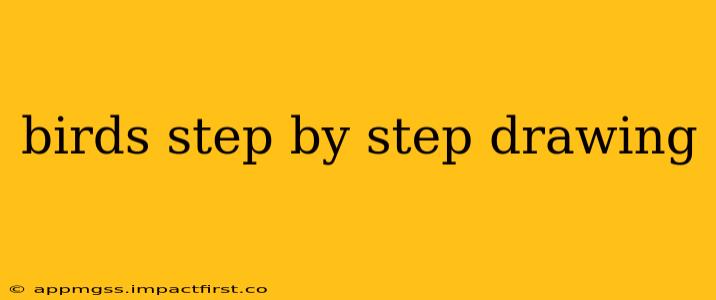Learning to draw birds can be a rewarding experience, opening up a world of artistic expression and observation. This guide provides a step-by-step approach suitable for various skill levels, from absolute beginners to those looking to refine their bird-drawing techniques. We'll cover basic shapes, proportions, and details to help you capture the essence of these fascinating creatures.
Understanding Bird Anatomy: The Foundation of Your Drawing
Before we begin drawing, let's briefly touch upon some key aspects of bird anatomy that will aid your artistic endeavors. Birds possess a unique skeletal structure, influencing their overall shape and movement. Understanding the relationship between the body, wings, beak, and tail is crucial for creating realistic and dynamic bird drawings.
What are the basic shapes of a bird?
Birds, at their most fundamental level, can be broken down into simplified shapes. Think of the body as an oval or teardrop, the head as a circle or slightly elongated oval, and the beak as a triangle or elongated cone. The wings and tail often resemble elongated teardrops or slightly curved rectangles. Using these basic shapes as a foundation helps you establish the overall proportions and posture of your bird before adding intricate details.
What are the key proportions of a bird?
Accurate proportions are key to a believable bird drawing. Observe the relationship between the head, body, and tail length. The wingspan is often longer than the body, and the legs are usually positioned towards the lower part of the body. Consider the bird's posture—is it perched, in flight, or swimming? The proportions will subtly shift based on its activity.
Step-by-Step Guide: Drawing a Simple Robin
Let's now walk through the process of drawing a common robin, a relatively simple bird to start with.
Step 1: The Basic Shapes
Start by lightly sketching the basic shapes: an oval for the body, a smaller circle for the head, and a small triangle for the beak. Position these shapes to reflect the bird's posture—perched, perhaps, on a branch.
Step 2: Refining the Body
Connect the head and body, smoothly blending the shapes. Add a curved line for the back and a slightly more defined line for the underside of the body.
Step 3: Adding the Wings and Tail
Sketch in the wings as slightly curved teardrops extending from the body. The tail should be positioned at the back, slightly fanning out.
Step 4: Defining the Details
Add details such as the beak, eyes, and legs. The robin's beak is relatively small and pointed. The legs are slender and positioned towards the bottom of the body. Add a few lines to indicate the feathers on the wings and tail.
Step 5: Adding the Finishing Touches
Refine your lines, adding subtle curves and textures to suggest feathers. Erase unnecessary guidelines and add shading to give your robin depth and dimension. Consider adding a branch or other elements to complete the scene.
Different Types of Birds and Their Unique Characteristics
How do I draw different types of birds?
Different bird species have distinct characteristics. For example, owls have large, round heads and prominent eyes; eagles have powerful, hooked beaks and broad wings; hummingbirds have long, slender beaks and iridescent feathers. Observe these unique features and adapt your drawing techniques accordingly. Study reference images and pay close attention to the details that define each species.
What are some tips for drawing birds in flight?
Drawing birds in flight requires capturing the dynamic movement of their wings and body. Focus on the streamlined shape of the bird, emphasizing the curves and angles of its body and wings. Consider the direction of the wind and how it affects the bird's posture. Practice sketching quick, dynamic lines to capture the essence of flight.
How do I draw birds realistically?
Realistic bird drawing requires keen observation and a focus on detail. Pay attention to the feather patterns, texture, and coloration of the bird. Study reference images and use shading techniques to create depth and dimension. Practice drawing individual feathers to better understand their texture and how they overlap.
By following these steps and continually practicing, you will improve your ability to draw birds with accuracy and artistic flair. Remember that consistent practice and observation are key to developing your skills. Happy drawing!
